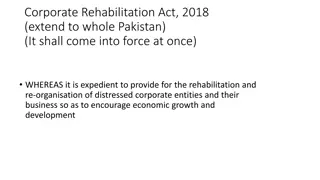Understanding Corporate Finance: A Comprehensive Guide
Corporate finance involves managing financial activities within a corporation to maximize shareholder value. It covers areas such as balance sheets, income statements, return on investment, and investor expectations. Investors play a crucial role by investing capital in exchange for potential returns, which can vary based on the level of risk involved. Investment decisions include allocating funds to various assets and contracts, such as debt and equity, to generate profits for the firm.
Download Presentation

Please find below an Image/Link to download the presentation.
The content on the website is provided AS IS for your information and personal use only. It may not be sold, licensed, or shared on other websites without obtaining consent from the author. Download presentation by click this link. If you encounter any issues during the download, it is possible that the publisher has removed the file from their server.
E N D
Presentation Transcript
CHAPTER 1 CORPORATE F NANCE S reyya Y lmaz -RA Working Capital Management 2018
PROCESS What is the corporate finance? What is the balance sheet and income statement? Return on Investment Investor s Expected Return Why this chapter is important?
CORPORATE FINANCE Corporate finance consists of the financial activities related to running a corporation, usually with a division or department set up to oversee the financial activities. Corporate finance is primarily concerned with maximizing shareholder value through long-term and short-term financial planning and the implementation of various strategies.
Who is investor? Investor who is willing to invest his or her capital in exchange for a return on the investment.
What do they care for? How much of a return? As a financial economists would say, the riskier the investment is, the higher the expected return.
What does investment include for investor? This money is invested in what is called the firm s assets, which include everything such as; property, plant and equipment, inventory and cash to less obvious items such as costumers financing. Small firms; investor makes all of the firm s investment other cases, particularly as firms grow, the firm s management are tasked with making these decisions.
What is the profit? A financial gain, especially the difference between the amount earned and the amount spent in buying, operating or producing something. There are two types of contracts; 1. Debt contracts 2. Equity contracts
Debt contract is one in which the firm schedules a promised repayment to the investor. The owners of the corresponding claim are called debt holders.
Equity contract which the firm assigns to investors what can be considered the firm s residual profit, that is, the profit that is left over after the firm covers its operating costs and its obligations to debt holders. The owners of the latter type of claim are named equity holders .
What is the basic financial statements? What is the balance sheet? What is the income statement?
The balance sheet provides a snapshot of the firm at a given moment in time. This report has two main parts: the left-hand side, which presents the assets of the firm, and the right-hand side, which shows the corresponding liabilities . The assets represent the investments made by the firm, whereas the liabilities characterize the way those assets have been financed.
Income statement The income statement is a representation of a firm s normal business operations between two consecutive balance sheet statements. In particular, it records the firm s total sales and costs incurred over the period, from which the firm s net income (or profit) is calculated.
As is the case for balance sheets, the income statement can be prepared for any desired period of time (a week, a month, a quarter, a year, etc.). Typically, a one year interval is used for tax and most legal purposes, but many firms also use quarterly or monthly income statements for different types of supplementary analysis.
Return on Investment When cash enters the company from sales, management distributes the cash among the firm s various claim holders. The first group of claim holders to be paid consists of employees and suppliers. After this group of claim holders has been satisfied, the remaining cash is distributed among financial claim holders.
First among such claim holders are debt holders, who are paid in accordance with the seniority of their claim and the terms of the firm s debt contracts. Next in line is the federal tax authority, which has a claim on the firm s profit. Finally, after paying employees, suppliers, debt holders, and the tax authority, the balance is distributed to equity holders, who are also called shareholders.
Investors Expected ReturnThe Cost Of Capital We can express investors expected return in general form as follows: ???????? ?????? = ??+ ???? ??????? where ??is the return promised by a risk-free investment and risk premium is the extra return that an investor requires for an investment with a given level of risk.
To consider the expected return of shareholders alone, let the cost of equity be denoted by ??. We can then say that equity holders expected return is given by: ??= ??+ ???? ???????? For completeness, with the cost of debt denoted by ??, we have that the expected return to debt holders is given by: ??= ??+ ???? ????????.
Notice that since equity holders face more ex ante risk than debt holders, and ??is the same for both equations, it follows that ???? ????????> ???? ????????and hence ?? > ??, reflecting equity holders higher risk and associated higher expected return.
The expression for the combined expected return of both debt and equity holders is called the weighted average cost of capital (WACC) the expected return is the firm s cost due to investors in exchange for receiving investment capital. WACC is computed as:
? ? WACC= ?? ?+?+ ?? (1 ?) ?+? ??and ??are as defined previously, E / (D + E) and D / (D + E) are the weights that equity and debt contribute to finance the investment, and X is the marginal income tax rate. Taxes enter the equation so as to allow us to compute the after-tax cost of capital.
Interest expenses can be deducted before determining taxable income, each dollar paid to the bank saves t dollars of taxes. As a result, the after-tax cost of debt is ?? (1 t ).
What do we learn? We acknowledge that the discussion in this chapter has been deliberately light. As the purpose of this book is not to explain in full the mechanics of financial accounting but to shed light on working capital management, The discussion in this chapter is simply intended to review some of the key concepts that serve as a foundation for further analysis.
Next weeks topic Homework: Research 2 companies balance sheet and income statement Introduction to Working Capital Thank you for attendance Lovely week























